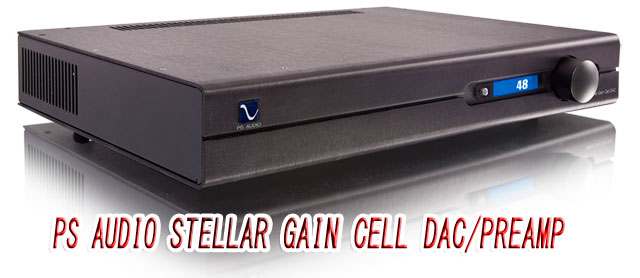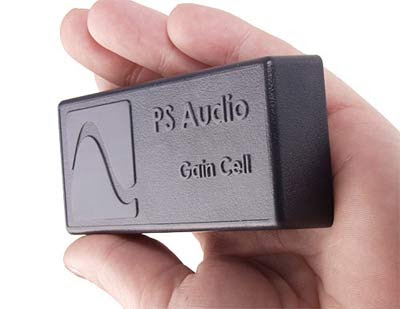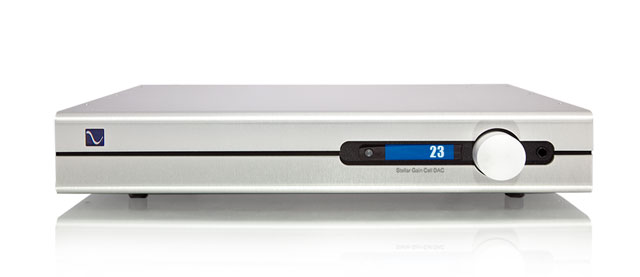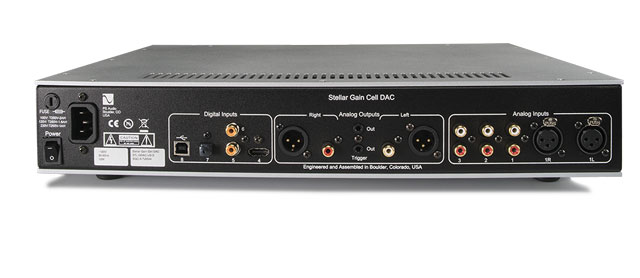PS Audio Stellar Gain Cell DAC Preamp

Life with a full-featured DAC and analog preamplifier
 Earlier this year, I reviewed the PS Audio Stellar M700 mono amplifiers and liked ‘em a lot (reviewed here). When I first heard PS Audio products would be coming my way, I was hoping the Stellar Gain Cell DAC/Preamp would be included and was disappointed that it wasn’t. Happily, it was passed my way shortly after the amp review was completed.
Earlier this year, I reviewed the PS Audio Stellar M700 mono amplifiers and liked ‘em a lot (reviewed here). When I first heard PS Audio products would be coming my way, I was hoping the Stellar Gain Cell DAC/Preamp would be included and was disappointed that it wasn’t. Happily, it was passed my way shortly after the amp review was completed.
For all of my audio life to date, I’ve held on to some of the better components while avoiding the latest craze when possible, more due to frugality than anything else. Until recently, I’ve relied on unbalanced connections with my older components not offering balanced. It wasn’t until the last few years, when a pair of balanced/unbalanced amplifiers made their way into my life, one at a time, that I thought about trying a balanced system. The Gain Cell, offering both options, made a balanced system review easy.
The Gain Cell is styled in the same sleek, industrial look as the rest of the Stellar line and comes in the same silver or black choice of finish. The chassis measures 17” x 12” x 3”. The front sports a volume control, 1/4” headphone jack and a blue lit power/standby button. The Stellar Gain Cell’s rear panel features an analog section with 3 pairs of line inputs and one XLR pair. The output section offers both balanced and unbalanced connections and its digital input section offers a plethora of digital options – USB, Toslink, coax and I²S (what looks like an HDMI input). The Gain Cell includes a trigger function for powering the Stellar on and off with other components and a main power switch located next to its IEC connector. The Gain Cell comes complete with a nice, useful remote that, other than basic functions, offers access to three digital filters as a means of fine-tuning for greater system synergy.
 According to PS Audio, “The real challenge designing the Gain Cell DAC was making sure both PCM and DSD were handled in a way that sacrificed as little as possible through the playback process.” Chief engineer Bob Stadtherr and CEO Paul McGowan worked together designing the ins and outs of the Gain Cell, “making decisions on power supplies, overall architecture, developing a custom, simplified FPGA for the input stage and voicing the output stage in a balanced and musical manner that honors both PCM and DSD formats.”
According to PS Audio, “The real challenge designing the Gain Cell DAC was making sure both PCM and DSD were handled in a way that sacrificed as little as possible through the playback process.” Chief engineer Bob Stadtherr and CEO Paul McGowan worked together designing the ins and outs of the Gain Cell, “making decisions on power supplies, overall architecture, developing a custom, simplified FPGA for the input stage and voicing the output stage in a balanced and musical manner that honors both PCM and DSD formats.”
Paraphrasing from the PS Audio website, the heart of the Gain Cell DAC analog preamplifier section is its “Variable Gain Cell,” invented by McGowan in the early 2000’s to eliminate the need for adding additional circuitry for a volume control, simplifying the signal path. The Gain Cell relies on a different topology known as the Gilbert Cell, topology invented to allow the preamplifier amplifier stage to vary its own gain in response to front panel volume control position. Widely used during the 1960’s in recording studios until digital replaced it, this method requires zero additional circuitry in the signal path and offers more than 80 db of attenuation to properly equal most high end preamplifiers, if designed properly.
The Gain Cell has 100% analog input switching and, when used in conjunction with the Variable Gain Cell, allows the user to listen within the analog domain. Coupled with a great DAC, this allows flexibility. The Stellar Gain Cell and preamp stage are fully balanced from input to output (unbalanced is also included as noted above).
 The the Gain Cell DAC chief architect was Bob Stadtherr, hand-tuning and voicing was completed by Paul McGowan and Darren Myers (the Stellar M700 mono amplifier was his baby). More from PS Audio’s site “All input signals are taken into the Gain Cell DAC in Native Mode, without Sample Rate Conversion (SRC) and fed directly into a simplified FPGA known as a CPLD (Complex Programmable Logic Device), which discovers [the] sample rate and format, reclocks all incoming data, reduces jitter, wave shapes data output to the DAC chip, and utilizes high speed/low gate count logic to reduce propagation delay for faster throughput. This proprietary technology is called the Digital Lens.”
The the Gain Cell DAC chief architect was Bob Stadtherr, hand-tuning and voicing was completed by Paul McGowan and Darren Myers (the Stellar M700 mono amplifier was his baby). More from PS Audio’s site “All input signals are taken into the Gain Cell DAC in Native Mode, without Sample Rate Conversion (SRC) and fed directly into a simplified FPGA known as a CPLD (Complex Programmable Logic Device), which discovers [the] sample rate and format, reclocks all incoming data, reduces jitter, wave shapes data output to the DAC chip, and utilizes high speed/low gate count logic to reduce propagation delay for faster throughput. This proprietary technology is called the Digital Lens.”
The acclaimed 32-bit ESS Sabre DAC chip, with its Hyperstream architecture, was selected for duty in the Gain Cell DAC. “The output is passively filtered to reduce transient distortion. the Gain Cell DAC’s power supply includes a large analog transformer, 7 regulators, properly-bypassed high-speed switching diodes, and a massive 15,000 mFd of storage capacitance.” The output stage is a unique, fully balanced and direct coupled hybrid array Class-A configuration, with an extended bandwidth feeding directly into Stellar’s Gain Cell.
A little more from PS Audio “The Gain Cell DACs I²S inputs are… compatible with [the PS Audio] DirectStream Transport… The DirectStream Transport is one of only a very few players to output pure DSD from the locked SACD layer of SACD discs. Only PS Audio DACs, such as DirectStream and DirectStream Junior—and now Stellar—are authorized to play the pure DSD layer in all of its glory.” Note “What Looks Like an HDMI Is Not” below for clarification.
Paraphrasing the manufacturer, The real challenge designing the Gain Cell DAC was making sure both PCM and DSD were handled in a way that sacrificed as little as possible through the playback process. The two designers developed a custom, simplified input stage and voiced the output stage in a musical manner that honors both PCM and DSD formats.
Listening
 I’ve had the Gain Cell around for a good while. After first breaking it in on my temp review setup, I moved it to the main rig to perform duty as the main preamp – this allowed my Conrad Johnson a well deserved bit of a rest. I connected to its internal DAC with my distant Mac Pro… 24 or so feet of Transparent Performance USB cable away – loft living creates some long run challenges. Thankfully, the Performance USB cable properly despite my adapting two lengths together with a USB 3.0 female to female adapter, with no dropouts or negative digital artifacts noted during play in a span considerably longer than USB 2.0’s technical limitation of 5 meters allows.
I’ve had the Gain Cell around for a good while. After first breaking it in on my temp review setup, I moved it to the main rig to perform duty as the main preamp – this allowed my Conrad Johnson a well deserved bit of a rest. I connected to its internal DAC with my distant Mac Pro… 24 or so feet of Transparent Performance USB cable away – loft living creates some long run challenges. Thankfully, the Performance USB cable properly despite my adapting two lengths together with a USB 3.0 female to female adapter, with no dropouts or negative digital artifacts noted during play in a span considerably longer than USB 2.0’s technical limitation of 5 meters allows.
With a balanced connection to one of my Emerald Physics EP100.2SE’s and on to my Tekton Double Impacts, along with the connection of a couple of nice sources (Memory Player Mini and an external phono stage for kicks), I was ready to listen.
 Chris Potter and the underground Orchestra’s “Imaginary Cities” (ECM 2015) is wonderfully orchestrated, lush, beautifully played and intriguing. My wife will love this on Sundays, it’s the perfect soundtrack for easing into a day – it reminds me a bit of of Claus Ogerman’s mid-70’s Gate of Dreams in its sensitivity and depth. The Stellar Gain Cell preamp and DAC combo brought these thoughtful and buoyant arrangements to life, as musicality flowed from the system effortlessly. The DAC of this DAC/preamp was quite sweet and easy listening for long periods. This was truly the kind of music you close your eyes to and let loft over you: its melodic enough to follow and interesting enough to keep you curious, capturing your full interest as it flows from mood to mood. There was a lot of love here, most assuredly the Gain Cell’s contribution – musicality and cohesiveness.
Chris Potter and the underground Orchestra’s “Imaginary Cities” (ECM 2015) is wonderfully orchestrated, lush, beautifully played and intriguing. My wife will love this on Sundays, it’s the perfect soundtrack for easing into a day – it reminds me a bit of of Claus Ogerman’s mid-70’s Gate of Dreams in its sensitivity and depth. The Stellar Gain Cell preamp and DAC combo brought these thoughtful and buoyant arrangements to life, as musicality flowed from the system effortlessly. The DAC of this DAC/preamp was quite sweet and easy listening for long periods. This was truly the kind of music you close your eyes to and let loft over you: its melodic enough to follow and interesting enough to keep you curious, capturing your full interest as it flows from mood to mood. There was a lot of love here, most assuredly the Gain Cell’s contribution – musicality and cohesiveness.
The third track, Imaginary Cities 2: Dualities, began with wonderful string plucks and a nice depth and presence to the instrumentation on an ample soundstage. There was nice drive and pace to the music throughout this percussive piece. Potter’s sax tone was very nice, with good body and depth and tone. The ferocity in that subtle sounding marimba’s playing was both unexpected and memorable.
On Track 5 Rebuilding, the Gain Cell really allowed the swinging in this track to come though. A surprising amount of imaging and instrument depth inhabited this longer tracks’ ebbs and flows… and its inspired guitar lines and warm sweet strings floated onto a very three-dimensional stage accompanied by the interesting and angular playing of the band members.
 The first few tracks on John Surman’s “Brewster’s Rooster” (ECM 2009) might fool you into think he’s mellowed a bit, given his presence over decades in the free jazz arena, but he still possesses the fire I first heard from him on John McLaughlin’s “Extrapolation” back in 1973. Boy did I love that record… so much so that I purchased a second copy as well as a Gibson Hummingbird like McLaughlin played on the date, that same year.
The first few tracks on John Surman’s “Brewster’s Rooster” (ECM 2009) might fool you into think he’s mellowed a bit, given his presence over decades in the free jazz arena, but he still possesses the fire I first heard from him on John McLaughlin’s “Extrapolation” back in 1973. Boy did I love that record… so much so that I purchased a second copy as well as a Gibson Hummingbird like McLaughlin played on the date, that same year.
With Kickback, Surman’s playing was more ferocious and complex. All the band’s members, John Abercrombie, Drew Gress and Jack DeJohnette, delivered fantastic accompaniment that allowed Surman to wade through a wide range of tonal and textural waters. The Gain Cell delivered impressive drive with solid dynamics and 3-D imaging, accompanied by nice depth in both soundstage and low frequencies.
The band’s reading of Chelsea Bridge was gorgeous and a tribute to such the greats who have recorded it before. The sax was sweet, rich, resonant and easy going, with the other players as unrushed and contemplative as Surman himself, proving that it’s the space between the notes that matters. The old Surman returned on Haywain, a spirited outing with the entire band locked into a great groove, delivering chops with a unified drive and passion. DeJohnette really drove here, letting the band members the space to stretch out. A truly great performance.
 Johnny Adams’ Baby Don’t You Cry, from his 1996 “One Foot in the Blues” CD, was up next. Adams was such an accomplished ballad singer and the arrangement were both tight, very well recorded, dynamic and spacious on this outing… but, man, when Dr. Lonnie Smith’s Hammond organ blasts off like a spaceship in your listening room, WOW! I first heard this tune in CP’s rig a few years back and sat transfixed at that spinning Leslie speaker doing it’s thing on the soundstage in front of me. The Stellar Gain Cell made part of this magic happen again.
Johnny Adams’ Baby Don’t You Cry, from his 1996 “One Foot in the Blues” CD, was up next. Adams was such an accomplished ballad singer and the arrangement were both tight, very well recorded, dynamic and spacious on this outing… but, man, when Dr. Lonnie Smith’s Hammond organ blasts off like a spaceship in your listening room, WOW! I first heard this tune in CP’s rig a few years back and sat transfixed at that spinning Leslie speaker doing it’s thing on the soundstage in front of me. The Stellar Gain Cell made part of this magic happen again.
Headphones
I sat back to try the headphone input of the Gain Cell with my Sennheiser HD650 (fitted with Cardas cables) and really liked what I heard. A sojourn through the Tomasz Stanko quartet’s “Suspended Night” (ECM 2004) proved quite worthwhile with its open airy and dynamic sense of realism. Percussion was well delineated, bass was solid, mids had convincing body and weight and the higher frequencies had a nice edge without being strident – all in all, quite enjoyable. “Something Coming” from Cecile McLorin Salvant’s “For One To Love” (Mack Avenue 2015), sounded vibrant, delivered with great drive and presented in a wide and deep space and with notable immediacy and punch.
The Package from “The Thirteenth Step,” A Perfect Circle’s 2003 release, came with power and urgency to my ears through the Gain Cell. Both broad and delicate dynamics presented themselves with both body and verve. Bass was plentiful and all was present in a nice airy space around the head.
Liberty, from Annette Askvik’s “Liberty” (Bird 2011) was totally enjoyable through the Gain Cell. The dynamics were solid, transient edges were crisp, spacial cues imparted a distinct realism and the sax had great body and impact. I really dug it, and that’s coming from someone who isn’t really a dedicated headphone listener. Perhaps things will change with the Gain Cell far longer in house.
What Looks Like an HDMI Is Not
In an attempt to offer a thorough review of the Gain Cell, noting a familiar slot on its rear chassis, I picked up a 6 Meter HDMI, hoping to take advantage of the above mentioned splitting and playing of the audio layer from SACD disc play. I don’t have a large collection of SACD discs and, with DSD files readily available for purchase as downloads, my interest in SACD has stalled the purchase of a dedicated SACD player. As such, I’ve since ripped my dozen or so discs to 24 bit 96kHz files for DAC play.
The PS Audio website states “The Gain Cell DACs I²S inputs are also compatible with our DirectStream Transport. What this means is important. The DirectStream Transport is one of only a very few players to output pure DSD from the locked SACD layer of SACD discs. Only PS Audio DACs, such as DirectStream and DirectStream Junior—and now Stellar—are authorized to play the pure DSD layer in all of its glory.“ I had hoped connecting via HDMI from our Oppo BluRay, which plays SACD, would connect to the “HDMI looking” 12S input for play of the audio layer of an SAC
Sadly, Input 4, (the preamp’s I2S input) didn’t produce any sound for me. Was this wishful thinking on my part or an understanding I lacked? I wrote Paul McGowan and received the following prompt reply: “Though we use the same HDMI connector, our I²S input is not HDMI compatible. It will only accept I²S inputs, which are not compatible with HDMI. Sorry for any confusion.” Paul further explained in a subsequent email, “Only a source with an actual I²S output, like our DMP or older PWT, have I²S outputs. The connectors use standard HDMI cables and inputs and outputs, but the formatting is different than HDMI. On the Gain Cell DAC it too has an I²S input you can use to connect to either one of these transports.”
Hmm… “Only PS Audio DACs, such as DirectStream and DirectStream Junior—and now Stellar—are authorized to play the pure DSD layer in all of its glory” Perhaps adding “when the Stellar Gain Cell DAC/Preamp is used in tandem with either our DirectStream or DirectStream Junior DAC” might be more accurate to say and alleviate future confusion. My 2 cents.
The Wrap
The PS Audio Stellar Gain Cell DAC/Preamp is a great piece of gear, offering some great features and, yes, stellar sound at a very good value. With the availability of up to 32 bit, 384kHz conversion, the Gain Cell’s internal DAC future proofs this piece of gear for years to come. It’s worthy to note that each Stellar product is hand-built in PS Audio’s Colorado facility, making your choice of this or any piece in the Stellar line a truly dependable choice.


greg voth
Specifications:
Price: $1699.00
Unit Weight: 13.5 lbs [6.1 kg]
Unit Dimensions: 17” x 12” x 3”
Shipping Weight: 17 lbs [7.7 kg]
Shipping Dimensions: 23”x 18” x 9”
Power requirements
Input Power: Model specific 100VAC, 120VAC, or 230VAC 50 or 60Hz
Power Consumption: 20W
Mains Power Input: IEC C14
Fuses:
100V T250V-2.0AH (2A Slow Blow)
120V T250V-1.6AH (1.6A Slow Blow)
230V T250V-1.0AH (1.0A Slow Blow)
Accessories included:
US (NEMA 5-15P) (all versions)
Schuko (CEE7/7) (230V version)
UK (BS1363) (230V version)
Analog inputs
RCA: 3 stereo pair
XLR: 1 stereo pair
Digital audio inputs
I2S:
1 PCM (384KHz max)
DSD64 DSD128
Compatible with DirectStream Transport SACD handshake for DSD playback
Coax: 2 PCM (192KHz max)
Optical: 1 PCM (96KHz max)
USB: PCM (384KHz max), DSD64 (DoP) DSD128 (DoP)
Format: PCM, DSD
Analog Audio Outputs
RCA: (Analog Unbalanced) 1 stereo pair
XLR: (Analog Balanced) 1 stereo pair
Headphones: One 1/4″ headphone connector front panel
Analog Performance
Gain: 12dB +/-0.5dB
Maximum output: 20 Vrms
Sensitivity: 5.3Vrms
Input Impedance: 47KΩ single ended RCA, 100KΩ Balanced XLR
Output Impedance: 100Ω single ended RCA, 200Ω balanced XLR
Frequency Response: 20Hz – 20KHz +0/- 0.25dB, 10Hz – 100KHz +0.1/-3.0dB
Noise: 20-20KHz
S/N Ratio: 1KHz >110dB (max output)
Channel separation: 1KHz >90dB
Input separation: 1KHz >90dB
THD&IM: 1KHz < 0.025%, 20-20KHz < 0.05%
Headphone performance
Output power @1% THD: 300Ω 300mW, 16Ω 3.25W
S/N Ratio 1kHz
Noise: >95dB (max output),
THD & IM 1Vrms out: 300Ω
Output impedance:
Features
Volume Control: 0-100 (1/2 and 1dB steps, 80dB total range)
Balance Control: 24dB each direction in 1/2dB steps
Home Theater Mode: Assignable to any analog input. Adjustable (in setup) to any level
Polarity (phase) Control – Digital sources only
Filter Control: 3 selectable digital filters (PCM digital sources only)
Trigger output: (3.5mm 5-15VDC) 2
Remote Control: Yes. Infra Red
Contact: 4826 Sterling Drive • Boulder, Colorado • 80301 • 720.406.8946
Our office hours are 8AM to 5PM Mountain Standard Time.
We are available via email: support@psaudio.com
sales@psaudio.com or by telephone:
720.406.8946 voice
720.406.8967 fax
Stereo Times Masthead
Publisher/Founder
Clement Perry
Editor
Dave Thomas
Senior Editors
Frank Alles, Mike Girardi, Russell Lichter, Terry London, Moreno Mitchell, Paul Szabady, Bill Wells, Mike Wright, and Stephen Yan,
Current Contributors
David Abramson, Tim Barrall, Dave Allison, Ron Cook, Lewis Dardick, John Hoffman, Dan Secula, Don Shaulis, Greg Simmons, Eric Teh, Greg Voth, Richard Willie, Ed Van Winkle, Rob Dockery, Richard Doron, and Daveed Turek
Site Management Clement Perry
Ad Designer: Martin Perry







Be the first to comment on: PS Audio Stellar Gain Cell DAC Preamp